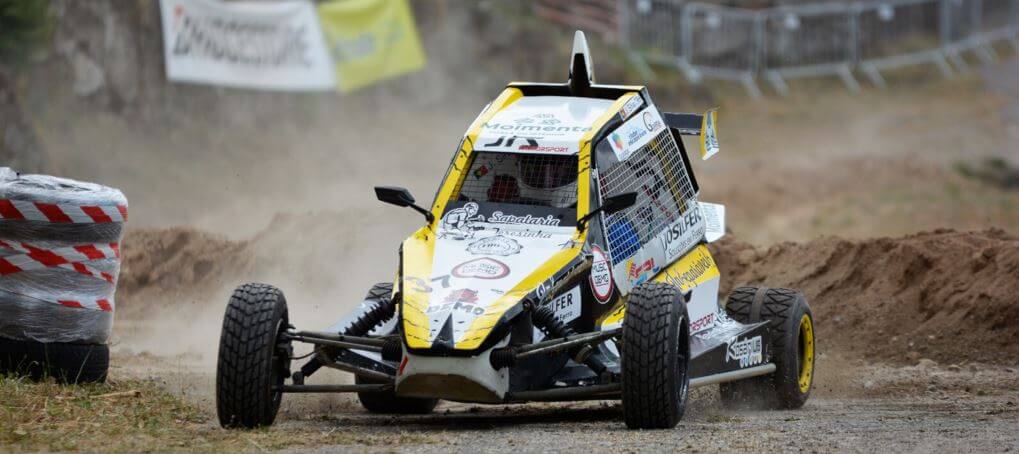Driving a 2CV on dirt tracks: inside the world of 2CV Cross
By RobinB on 19 August 2025 Kartcross / Autocross RallycrossMotorsport is full of spectacular disciplines that remain accessible without spending a fortune. Among them, 2CV Cross holds a special place. A mix of popular tradition, friendly paddock atmosphere and demanding dirt driving, it now offers one of the best cost / fun / show ratios in motorsport 😎
Open to drivers from the age of 16, both in the FFSA French Cup and in the 2CV Top Cross UFOLEP, the discipline appeals just as much to young people discovering competition as to seasoned enthusiasts who have been racing for the sheer pleasure of it for decades.
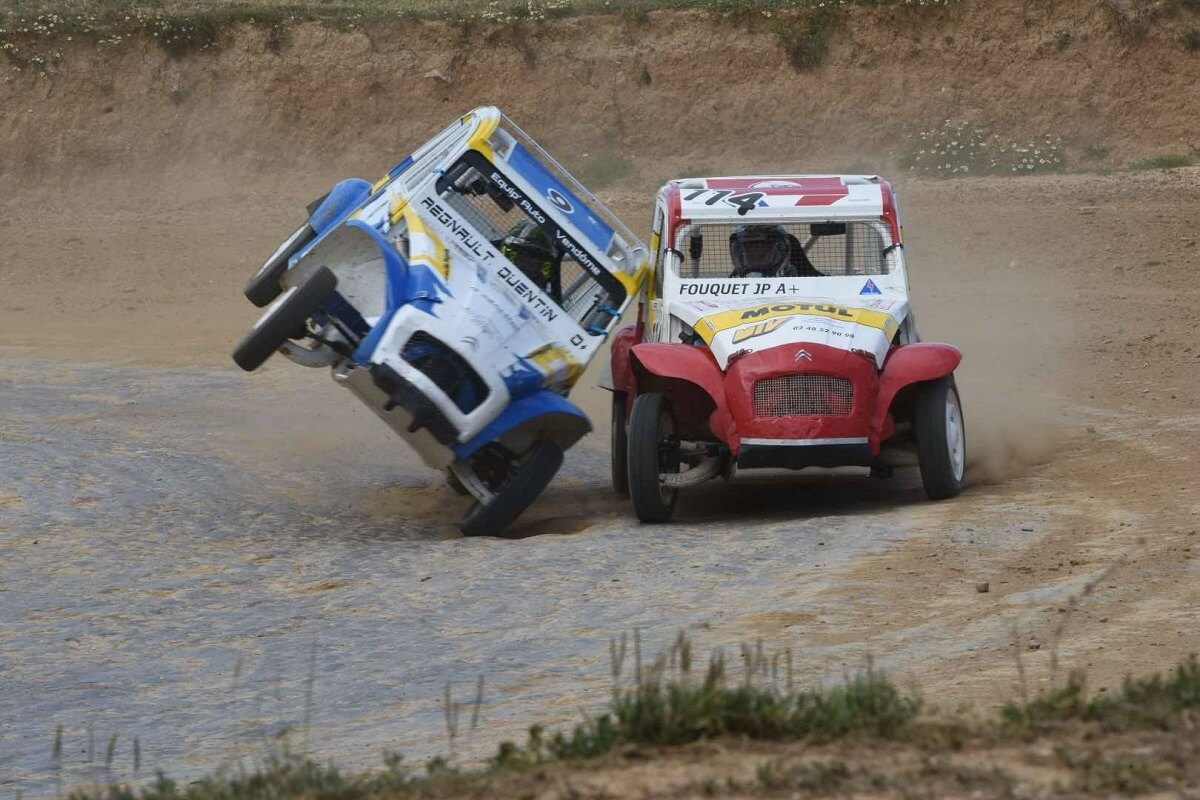
ℹ️ In this article, we dive into the world of 2CV Cross: from its origins to the rules governing the category, through the car preparation — original 602 cm³ engine, short 2CV4 gearbox with 8/33 final drive, reinforced chassis, 6-point roll cage —, the tracks and calendar, the budgets to compete, and the differences between the official FFSA series and the 2CV Top Cross run under UFOLEP.
From raids to dirt tracks: the birth of 2CV Cross
The story of 2CV Cross begins in the very early 1970s, following the major raids organised by Citroën to demonstrate the robustness and simplicity of its small saloon. In 1970 came the Paris–Kabul; in 1971, the Paris–Persepolis. Images of 2CVs tackling improbable tracks, loaded with luggage and dust, made a whole generation dream. These expeditions proved that the modest Citroën could handle thousands of kilometres in extreme conditions… without ever really reaching its limits 💪
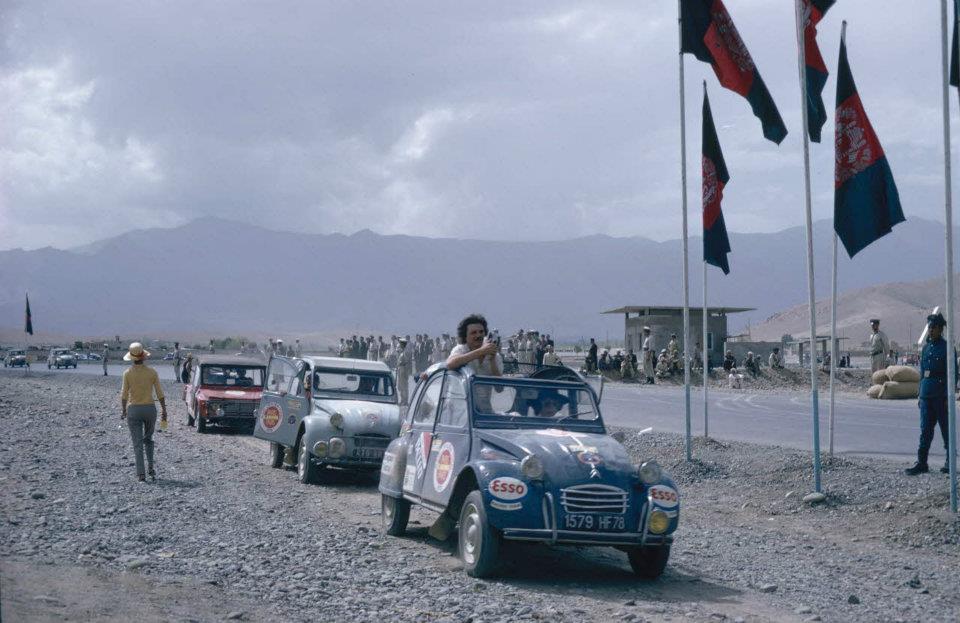
In 1972, while a new African raid was planned but postponed to the following year, the idea arose to recreate in France the atmosphere of these adventures. Jacques Wolgensinger, Citroën’s PR director, imagined a dirt event that would put the 2CV to the test while remaining affordable. With photographer Alain Beauvais, a former participant in the Paris–Kabul, he scouted a disused sand quarry in Pêchereau, near Argenton-sur-Creuse.
The goal: to invent a 24-hour endurance race, inspired by Le Mans but adapted to the spirit of the 2CV. Citroën seized the opportunity, set up regulations approved by the French Motor Sport Federation, and invited the former participants of the 1970 and 1971 raids 💌
1972 24 Hours of 2CV – Three categories based on engine displacement ⚙️
- 425 cm³ (before August 1967)
- 425 and 435 cm³ (after August 1967)
- 602 cm³ for 2CV, Dyane and Méhari
On July 22 and 23, 1972, the very first Pop’Cross – the name given to the event – took place on the dirt track of La Fonteneuille. Seventy-four cars (2CV, Dyane, Méhari) specially prepared for the occasion took the start, driven exclusively by young people under 30. The races were run in knockout heats, both day and night, with top speeds approaching 70 km/h. The regulations already required a roll cage and helmet, showing that safety was taken seriously.
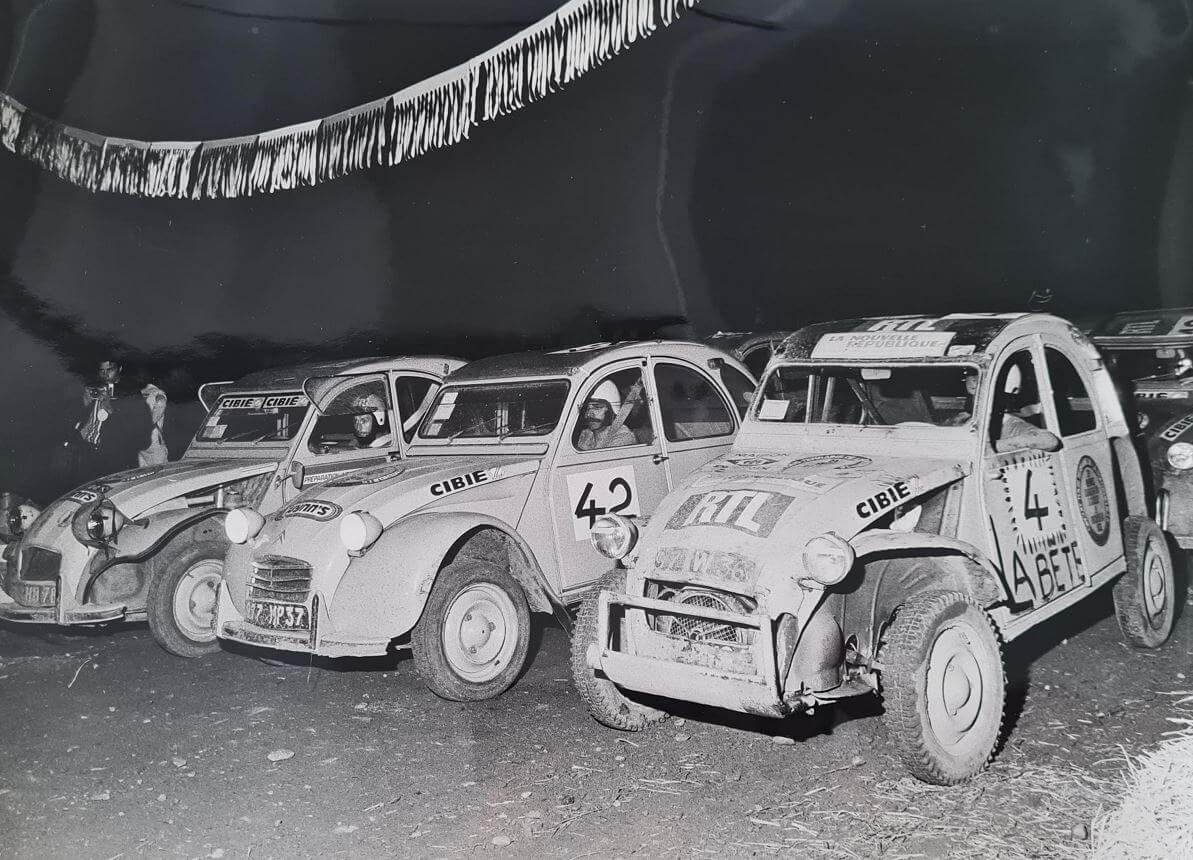
The public turned out in force: nearly 30,000 spectators attended the event, broadcast live on RTL 😲
🏆 Victory went to Jean-Claude Mouret, 23 years old, an apprentice mechanic from Mézières-en-Brenne, who won an orange 2CV 6 specially equipped for the 1973 African raid. Also present was a certain Rémy Cordebar, who would later pass the passion on to his four brothers… and to his father, then aged 70.
The success was such that by 1973, three new events were organised. In 1974, there were already seven, with a national championship supported by Total and Michelin. In 1975, the format became international with 17 events in 5 countries and no fewer than 630 competitors. Some weekends even drew 19,000 spectators and up to 800 participants over a full season. A huge success! 🥳
The 1980s and 1990s marked the golden age, with more than 140 regular drivers each year. Figures such as André Toton (president from 1982 to 1998) and then Joël Cruchet (until 2016) modernised the discipline, notably with the introduction of transponders and closer ties with the FFSA via the “2CV Cross / Fol’Car” commission. Since 2016, the association has been chaired by Julien Desaché.
➡️ See the official website of the Groupement 2CV Cross France
Even though the health crisis reduced the number of participants, 2CV Cross has retained what made it so successful: a friendly atmosphere, a popular spirit and an authentic spectacle, where the little Citroën continues to prove it hasn’t lost any of its endurance.
How does a 2CV Cross race work?
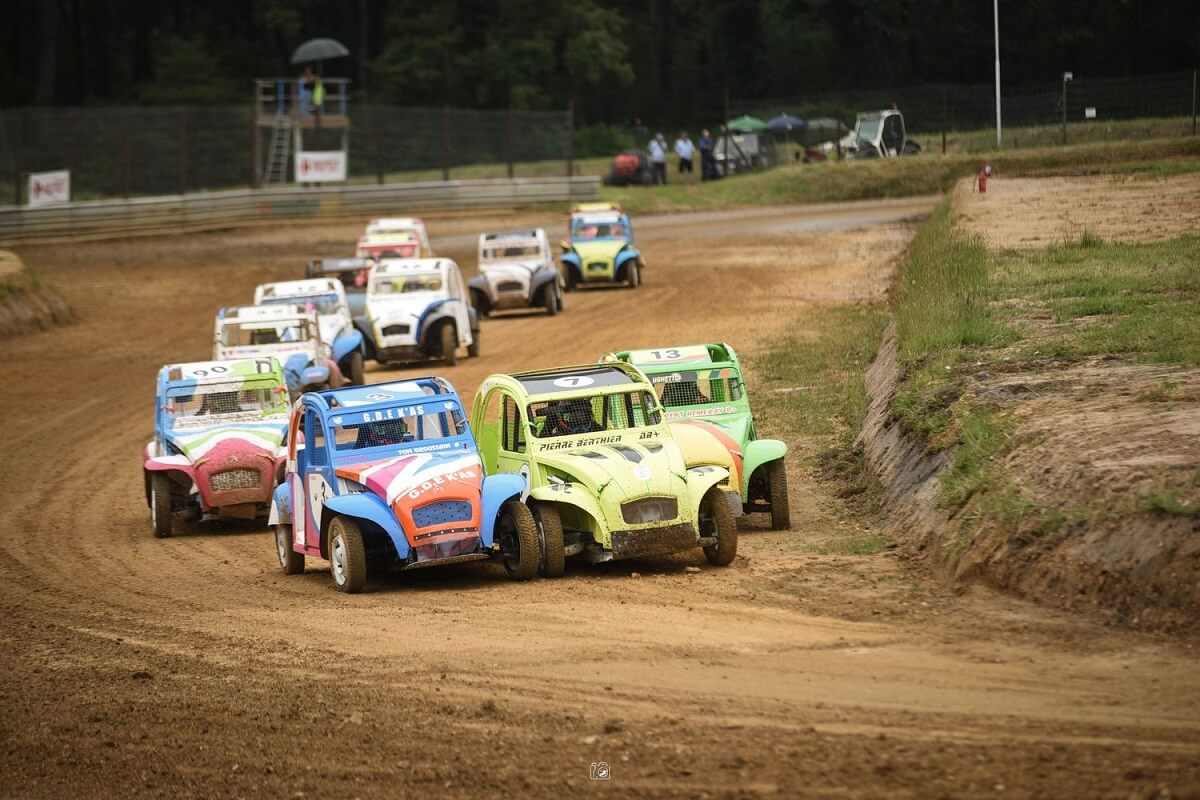
2CVs battling in packs, fender to fender, kicking up clouds of dust and roaring in a noise that, once completely free and thunderous, is now restricted by noise regulations. Gone are the days of open exhausts: the cars must now be fitted with silencers to stay under 100 dB. And when we say “pack,” we don’t mean six or eight cars like in rallycross: in 2CV Cross, the A and B finals line up 25 cars on the grid, delivering a breathtaking start and constant traffic on track 💥
See also: "How to Get Started in Rallycross in France?"
Today, the races are organised by the National Association of 2CV Cross Organisers, which ensures that the regulations are respected and provides all the necessary information to drivers and teams to prepare a compliant car 📋
The events take place on dirt tracks, often dedicated circuits or rallycross layouts. The programme usually runs over one or two days, depending on the number of entries:
- Two days: the chosen format when the grid exceeds 50 drivers.
- One day: possible if there are fewer entrants, while keeping all the key phases.
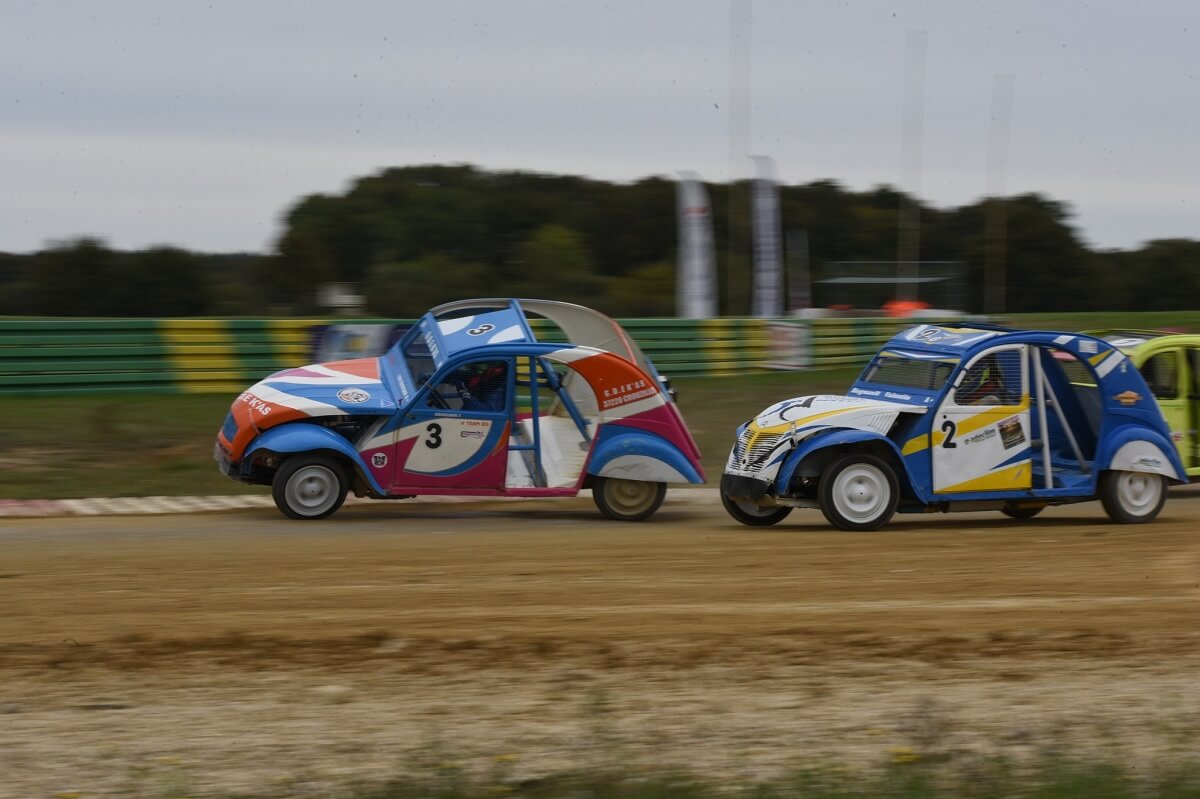
The standard format set by the regulations
- Free practice to get familiar with the track.
- Timed practice to establish the starting grids.
- Three 8-lap qualifying heats, awarding points to determine access to the final phases.
- Women’s and/or beginners’ races (8 laps), optional but encouraged to promote the discipline.
- Two 12-lap semi-finals, reserved for the top 50 from qualifying.
- Final B (10 laps)
- Final A (15 laps), which determines the event winner
- Possibly a Final C (8 laps), known as the “consolation” race, for those who could not qualify higher
Even at 100 km/h maximum, the action is intense. Overtaking under braking in tight corners, spectacular slides and inevitable — but marshals-regulated — contact are all part of the show 😎
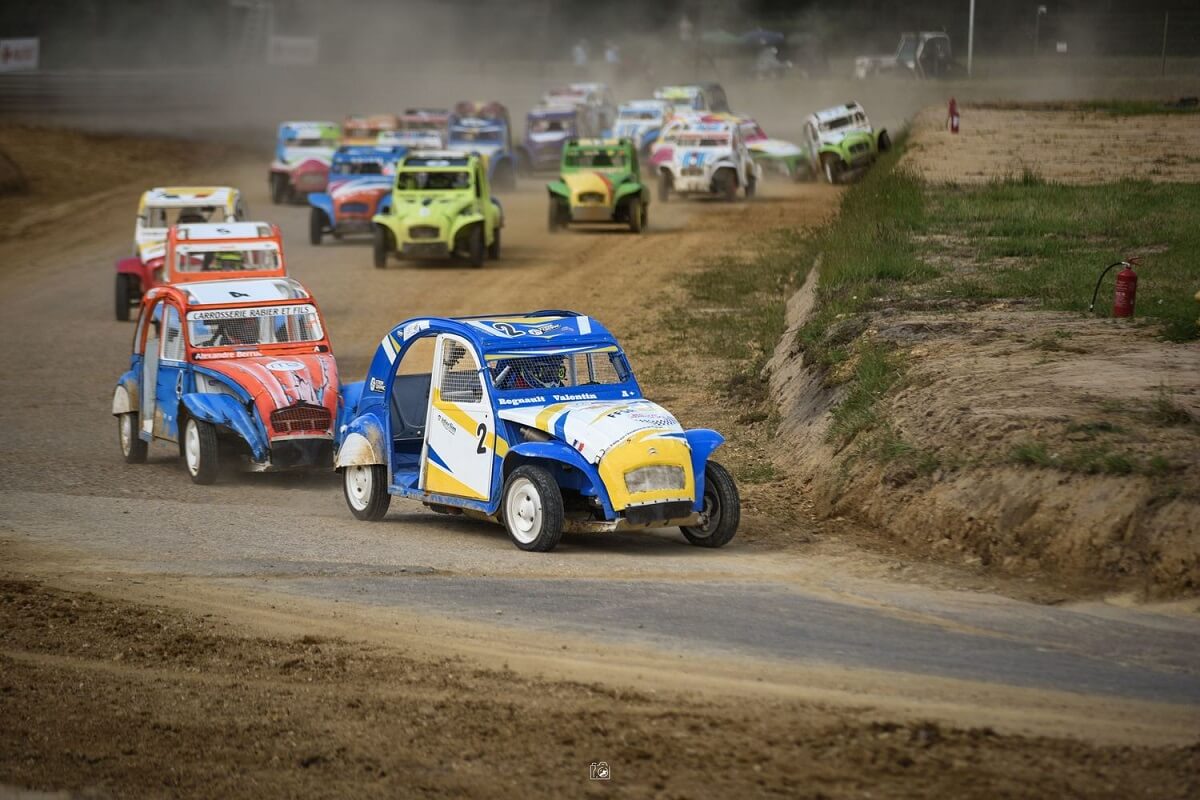
Spectators, often positioned high up, can see almost the entire track and enjoy an atmosphere that is both family-friendly and electric. In the paddock, friendliness is the rule: it’s not unusual to see two competitors, bonnet open, rebuilding an engine on a tarp laid on the grass while a neighbour brings drinks… and a driver who has just had an accident being helped by his rivals to get going again. This mutual assistance, almost “old school”, contrasts with the more tense atmosphere sometimes found in other disciplines, and contributes to the unique charm of 2CV Cross 🥰
Technical sheet and preparation of a 2CV Cross
The regulations are clear: the 2CV Cross remains a 2CV or Dyane, with original mechanics. The engine is the famous 602 cm³ flat-twin with around 29 DIN hp, air-cooled. The gearbox must be that of a 2CV 4 fitted with the 8/33 final drive.

Differential locking is prohibited, even partial, and manufacturer dimensions must be respected. Any modification aimed at gaining horsepower is forbidden: no port polishing, no altering valve diameters or lightening moving parts. Even oil or fuel additives are banned. This technical strictness helps keep costs low and avoids the “arms race” that often burdens other championships 🥵
This single-make constraint guarantees technical fairness and avoids the cost escalation seen in other disciplines 🤑
For the transmission and chassis, some improvements are allowed for reliability: reinforcement of the gearshift linkage, rear elastic mount, or mounting points. Brakes can be disc or drum depending on the original configuration.
The bodywork is extensively lightened: removal of the rear doors, soft top, windows replaced by mesh, and all unnecessary accessories stripped out. Vital components are reinforced to withstand impacts: reinforced chassis, front and rear axles often from the Ami 8 or Acadiane, specific shock absorbers. The suspension, known for its “boat-like” comfort on the road, is stiffened for more precise behaviour on dirt 🎯
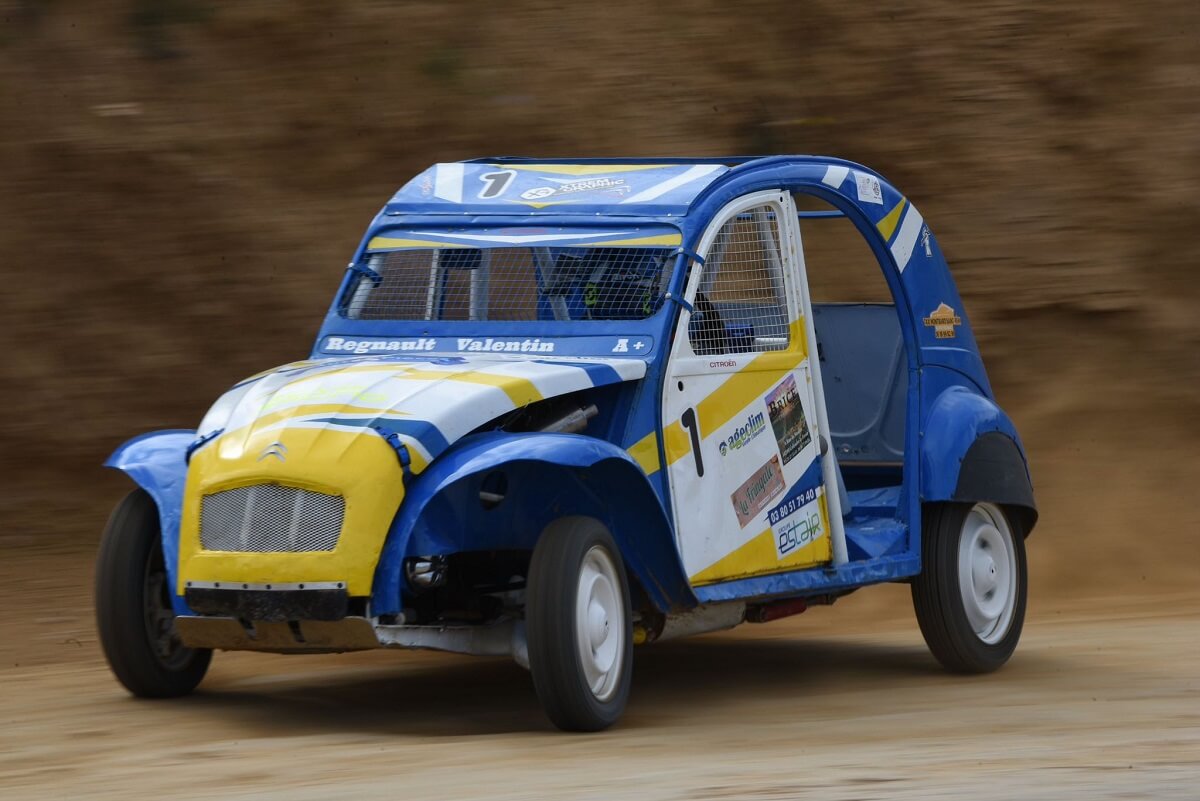
In most cases, the cars are purpose-built for competition from an Ami 8 chassis, considered more robust than the original, then shortened to fit a 2CV or Dyane body shell. Suspension pots, often from the Acadiane, allow the ride height to be lowered to around 12 cm at the front and 13 cm at the rear, making the car sharper and encouraging rear-end sliding when lifting off the throttle. The authorised shock absorbers are limited to certain models (oil-filled Gabriel or gas-filled Bilstein). Some drivers even adjust the height wheel by wheel to compensate for their weight, so the car sits perfectly level once aboard ⚖️
Safety is a key point: welded 6-point roll cage, rigid roof, homologated bucket seat, FIA 4- or 6-point harness in 3 inches with aircraft buckle, master switch… Even though top speed rarely exceeds 100 km/h, rollovers and side impacts are part of the game, and the regulations impose a level of protection comparable to other FFSA disciplines.
Tyres are also regulated by an official list updated each season. It includes models such as Hankook (K715, W442, W452), Firestone F560, Tracmax and Tristar. This limitation avoids any arms race and keeps the tyre budget under control while ensuring similar performance between competitors.
[VIDEO 📺] 2CV Cross - Starts, contact and on-track battles 🔥
FFSA and UFOLEP: two pathways, two atmospheres
Today, 2CV racing on dirt tracks takes place under two banners:
- The FFSA (Fédération Française du Sport Automobile), which oversees the French Cup of 2CV Cross;
- The UFOLEP (Union Française des Œuvres Laïques d’Éducation Physique), where the “2CV Top Cross” category is part of the Poursuite sur Terre events.
In FFSA, you are in the official pathway, with a national calendar, strict technical and sporting regulations, and often well-filled grids. The required licence is a regional dirt licence (or a participation permit), available from the age of 16, and entry fees remain very affordable, around €75 per race.
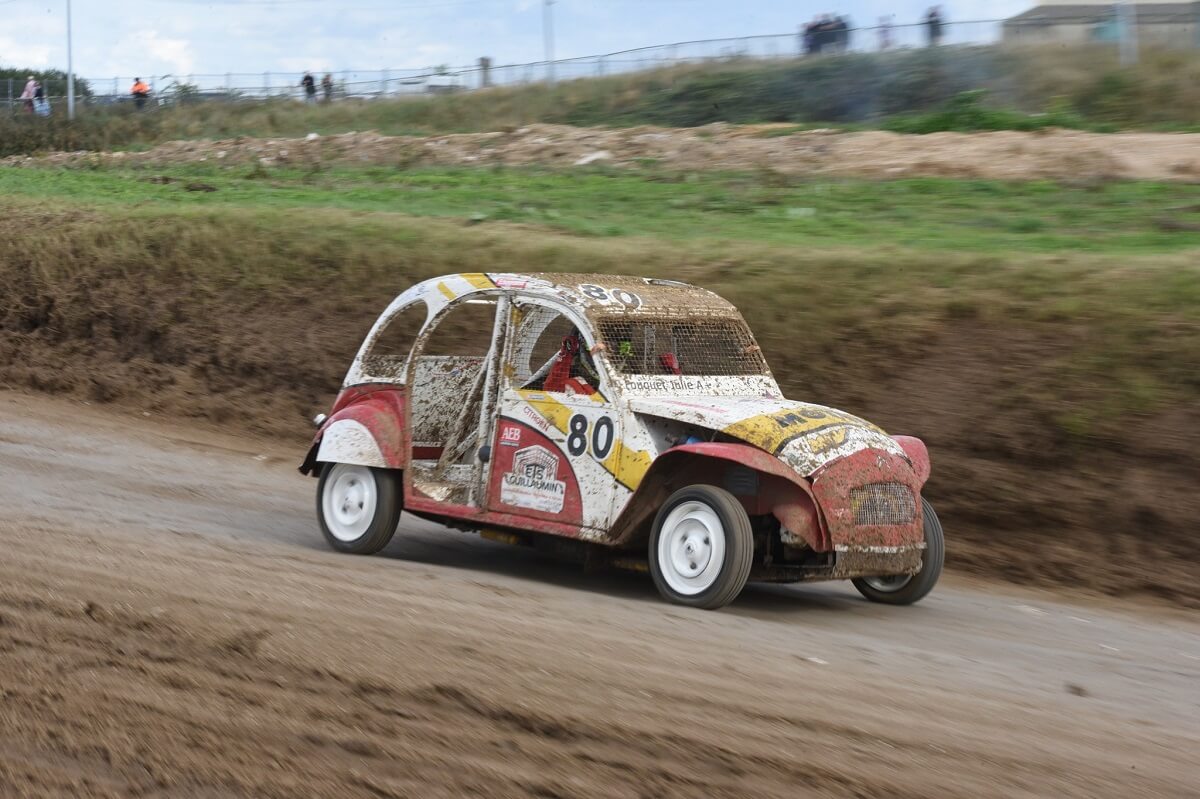
In UFOLEP, the discipline exists mainly on a regional scale, with an identical technical format since the regulations are taken directly from the FFSA (602 cm³ engine, 2CV 4 gearbox with 8/33 final drive, approved tyre list, safety requirements). The difference lies mainly in the organisation: a more localised calendar and a very community-based atmosphere. Young people aged 16 to 18 are allowed but must obtain a Certificat d’Aptitude Automobile (C.A.A.) before competing.
In summary:
- FFSA: national pathway, strong participation, broader visibility.
- UFOLEP: same technical regulations, more local and community-based setting.
2CV Cross – Circuits and the FFSA calendar
The FFSA French Cup of 2CV Cross is contested on an annual calendar of 7 to 10 rounds (8 rounds in 2025), spread across different regions, allowing the discipline to reach a varied audience. The tracks are almost all dirt, sometimes shared with rallycross or occasionally used by other off-road disciplines.
📅 2025 Calendar – French Cup of 2CV Cross
- Pont-de-Ruan / Saché (Indre-et-Loire): opening round in a hilly setting in the heart of Touraine.
- Elne (Pyrénées-Orientales): at the foot of the Albères, a sunny and fast track with a Mediterranean atmosphere.
- Sougy (Loiret): technical circuit that usually hosts two rounds in the year.
- Laon (Aisne): historic track with strong grids and a loyal crowd.
- Servilly (Allier): summer meeting shared with Fol’Car.
- Allogny (Cher): September round, often decisive for the championship.
- Châteauroux – Saint-Maur (Indre): often chosen to host the final, with facilities suitable for a large audience.
One of the special features of 2CV Cross is that the vast majority of weekends are shared with Fol’Car. This coexistence allows sharing of organisation and infrastructure (marshals, medical services, pits) while offering the public a varied programme. On the same day, you can see the tight packs of 2CV Cross followed by the equally spectacular starts of Fol’Car 🙂
In 2025, the calendar keeps this balance between “historic” rounds and more recent meetings, ensuring the discipline remains a regular fixture in both regional and national motorsport.
Budgets to compete in 2CV Cross
This is without a doubt the most common question from those interested in 2CV Cross. The entry cost remains one of the discipline’s main advantages, but it varies depending on whether you opt for a ready-to-race car or build one from a base vehicle.
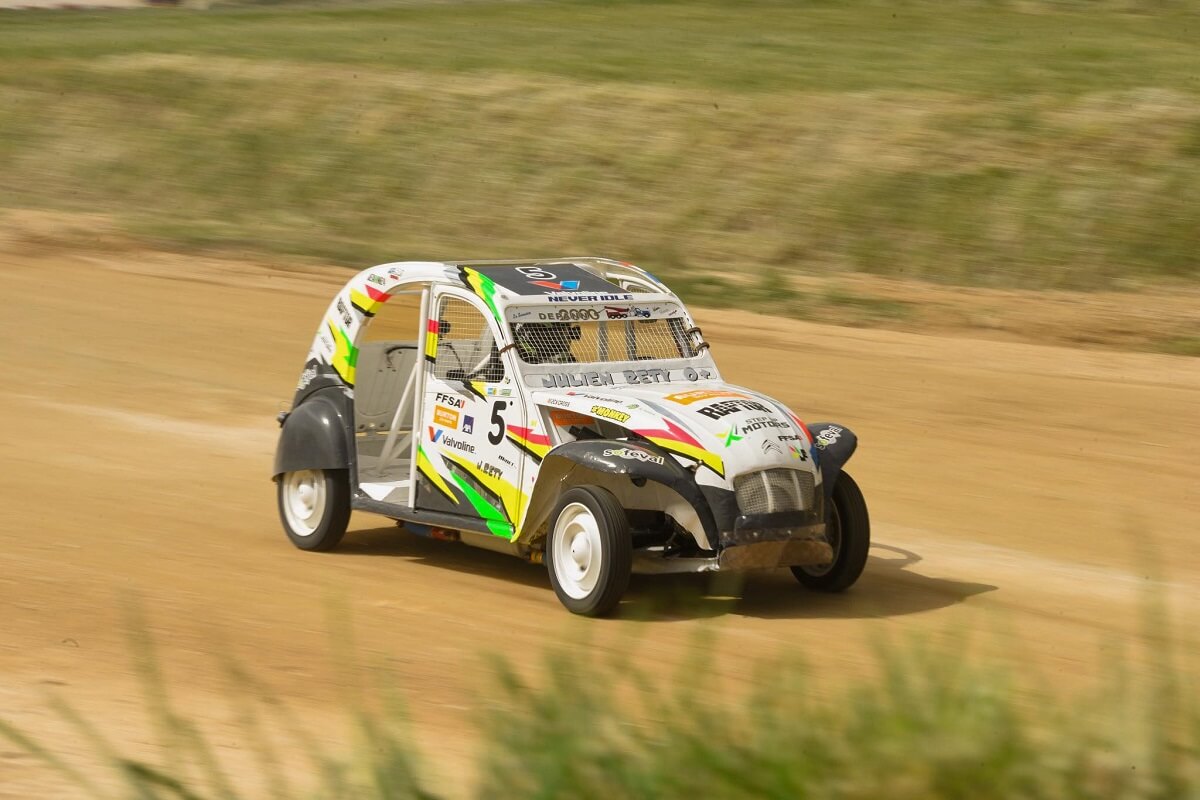
Buying second-hand
The quickest solution is to buy a second-hand 2CV Cross already ready to race. These cars are usually found through word of mouth, in the paddocks, or via specialist groups on social media. You can also check the race car classified ads on GoToTheGrid. Prices generally range from €3,000 to €6,000 for a car ready to race and in decent condition. Of course, the price will depend on the overall condition of the car, the freshness of the engine, the compliance of the roll cage, which must be flawless and meet regulations, as well as the spare parts included (tires, axles, gearboxes, etc.).
ℹ️ According to some specialists in the category, the price of a car capable of fighting for victory can (quickly) exceed €5,000 💶
Building a car
For those with mechanical skills, it is possible to start from a used 2CV or Dyane in average condition, often available for reasonable sums. You then need to install a homologated roll cage, reinforce the chassis, fit a bucket seat and FIA harness, prepare the running gear and comply with the technical regulations.
It is strongly advised against starting from a stock example in good condition or restored: in the current market, a well-preserved original 2CV easily exceeds €10,000, and the most sought-after models can go over €15,000. Investing such amounts only to push it hard on a dirt track would be a real waste 😁
ℹ️ To build a 2CV Cross, drivers use body shells and panels that would be unusable for restoration, whereas restorers rely on reproduction parts.
Renting a car
Some teams offer “arrive & drive” packages including the car, transport, assistance, tyres, fuel and sometimes driver coaching. The average price is around €1,000 for a full weekend (excluding damage).
On top of the purchase or rental budget, there are of course the essential costs to run for a full season: licence, entry fees, approved tyres, routine maintenance and spare parts, as well as travel at the circuits. By optimising preparation and parts management, it is possible to contest a full season with an annual budget between €3,000 and €5,000, making it one of the best cost/sensation ratios in motorsport 👍
Why try competing in a 2CV?
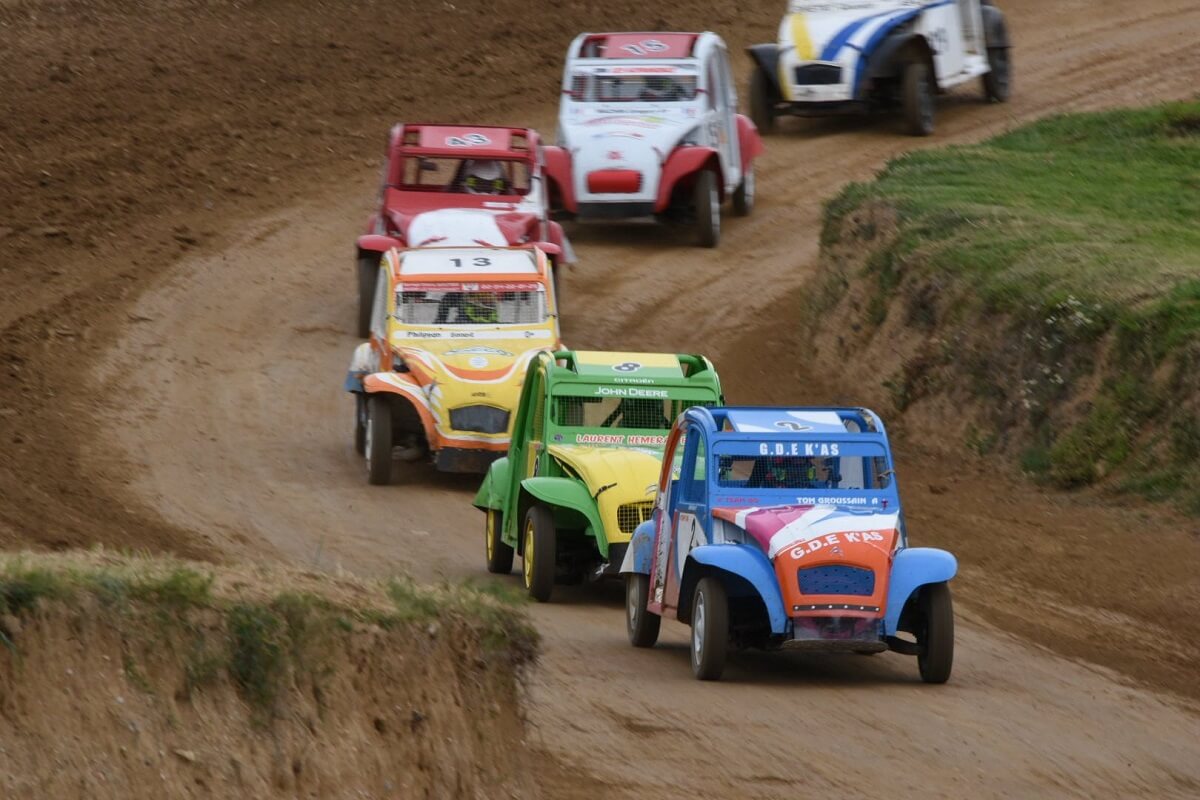
2CV Cross is anything but slow or boring. Sure, top speed is modest, but the light weight of the car, its playful behaviour on dirt and the density of the field make it a very spectacular discipline.
The spectators love it: clouds of dust, “rugby-style” but controlled contact, and an always good-natured atmosphere.
In the service areas, competitors chat, exchange parts, and even help a rival get going again after a collision. This genuine mutual support, in an old-school spirit, is one of the reasons why many drivers return season after season.
On track, 2CV Cross is also a true driving school: reading the surface, managing weight transfer, handling traffic… all skills that are useful in every motorsport discipline.
See also: "2CV/C1 Racing Cup: a unique endurance championship in Belgium"
Conclusion

2CV Cross remains a monument of popular French motorsport. Born from a slightly crazy bet in the early 1970s, this category has crossed the decades while keeping its original spirit: accessible, friendly and incredibly fun. Whether you choose the FFSA pathway with its structured national championship or the UFOLEP version, everyone can find their place. With a still reasonable budget, a unique atmosphere and raw sensations, it’s a discipline worth experiencing at least once. And who knows? A first race could be the start of a long story… 🔥
ℹ️ A big thank you to Morgane Lebrun for her superb photos illustrating this article, used with her permission. ➡️ Check out her work here.





